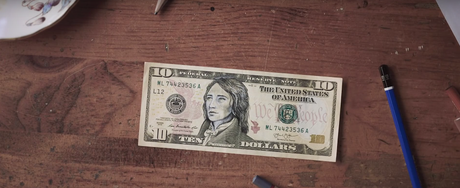
AAUW: https://www.youtube.com/watch?t=27&v=G_ikzQM93W8
I took a seat on a vinyl chair next to my father in the event room of the American Legion in Weehawken, New Jersey. Weehawken is an urban township across the Hudson River from New York City, and its greatest claim to fame is that Alexander Hamilton, the founder of the National Bank and first Secretary of the Treasury, was shot there in a duel by Aaron Burr in 1804.
I have lived in Weehawken my entire life. I have attended duel reenactments and visited the rock against which Hamilton supposedly slumped after being hit. On this year’s anniversary of the July 11th duel, there was even a lecture on Hamilton and Burr’s relationship and the nature of dueling in general.
I opened a brochure that had been placed on my chair to find an insert with “KEEP HAMILTON ON THE $10 BILL” typed across the top and a reproduction of Hamilton’s currency portrait beneath. On the back, a local committee implored residents to write to representatives and treasury officials and ask that Hamilton — the symbol of fiscal innovation and Weehawken’s only envoy into the wider United States — remain on the currency.
This plea comes in the context of the much-discussed, largely successful campaign Women On 20s. While women have appeared on American currency before — including Sacagawea and Susan B. Anthony dollars and Martha Washington’s brief appearance on a $1 dollar certificate — women usually appeared as allegorical figures and none have been women of color. On May 12th, therefore, Women On 20s presented a petition to President Obama asking that the $20 bill be redesigned to feature a notable American woman in place of President Andrew Jackson. Harriet Tubman was the winner of the poll to determine which historical figure would receive this honor.
In June, U.S. Treasury Secretary Jacob Lew announced that a woman would appear on the $10 bill in 2020 — just in time for the hundredth anniversary of the passage of the 19th Amendment and women’s voting rights. But the woman in question will share the honor with Hamilton rather than replace him. The bill, it was noted, was due for redesign anyway and will also feature anti-counterfeit technology and tactile aids for the sight-impaired. Lew solicited suggestions for candidates just as Women On 20s.
The Weehawken pamphlet, however, was the first I heard that such a change to the ten, and not the twenty, was in the works. Although the committee was partly misinformed about Hamilton being ousted altogether, I was outraged that residents would actively campaign against giving a woman a place on our currency — and out of a possessiveness towards Hamilton alone, no less.
I was not alone in my frustration either, as many took to Twitter to oppose a female leader sharing space with a white male founding father. Plus, $10 bills are circulated at only a 1-to-4 ratio to twenties, which will reduce the portrait’s visibility. The gesture is too small and inconsequential, many argue, and fits too neatly into the U.S. government’s predetermined plans.
And yet, as a Weehawken resident and American, I believe it makes sense to leave Hamilton on the $10 bill, as he made significant contributions to the founding principles and economic structure of the nation. Instead, we should focus on Women on 20s’ original call to boot Andrew Jackson off the $20 bill. Jackson has outlived his usefulness as a symbol of democratic participation and recognizing this by replacing him would be a momentously positive move in the era of Black Lives Matter and fourth wave feminism, especially considering Jackson’s history of genocidal violence and racism that earned him a reputation as one of the least successful presidents in history.
The Women On 20s campaign and the ensuing response have demonstrated what the American public wants. Now, we must channel public opinion into a concrete decision that creates positive visibility and gives voice and representation to still-marginalized groups of Americans.

